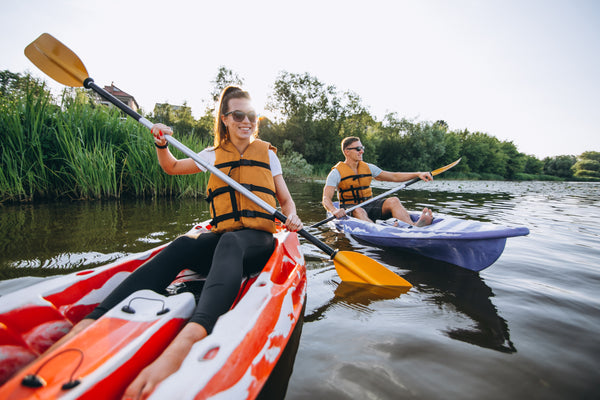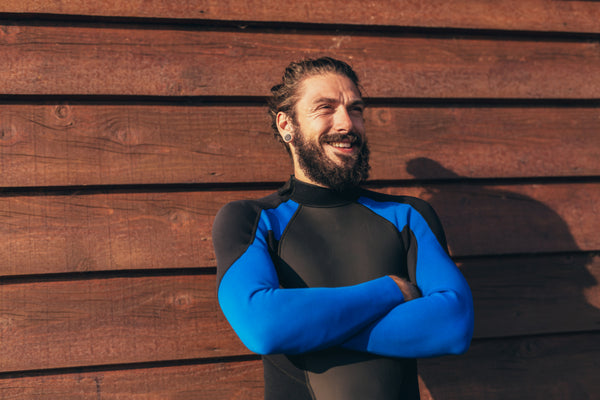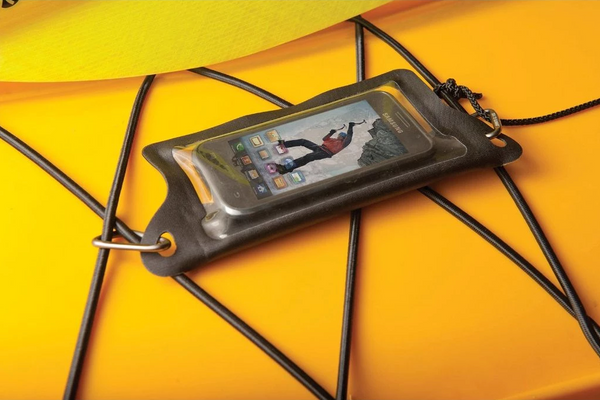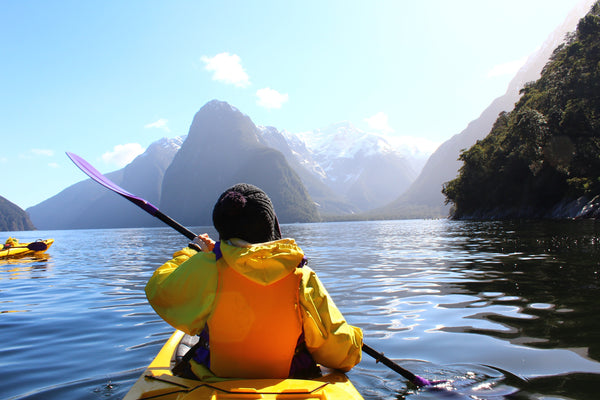How to Dress for Kayaking
Sep 02, 2019
Originally published on Sept. 2, 2019. Updated on June 29, 2023.
Kayaking is a great way to explore, get active and gain a new skill. However, as with all outdoor activities, dressing correctly for the occasion is vital to enjoying your time on the water.
What you should wear for a paddle, to ensure ultimate comfort, can vary greatly depending on the conditions both in and out of the water. There is a general rule of thumb with kayaking that you should dress for the water temperature, not the air temperature, but dressing for changeable conditions can be daunting.
To help you get started, this guide takes you through the dos and don’ts of dressing for your kayaking adventure.

The Basics
Some guidelines remain the same, no matter the weather conditions – these are the basics.
Safety first
Always wear your personal flotation device (PFD) or lifejacket while on the water. Some people find life jackets restrictive when paddling, so it’s worth investing in a kayak-specific lifejacket to provide as much freedom as you need. These are potentially life-saving pieces of equipment: set aside any concerns about looking ‘cool’ and put one on.
For more information about kayak safety, read our Top 10 Tips for Kayaking Safely.
Move freely
Don’t let restrictive clothing cramp your style when kayaking. Ensure that your clothing choices allow you to remain comfortable for long periods sitting down and that they don’t restrict your movement. You can find a good range of kayaking life jackets here, you'll notice some such as the Resolve Touring has nice cut-aways around the chest area to ensure your life jacket doesn't get in the way of your paddle strokes.
Dress for the water, not the weather
It might be warm outside but, if you end up in the water, your enjoyment could be ruined by the discomfort of colder water – in more extreme cases, you could even get hypothermia. Think about wearing a wetsuit or dry suit and ensure that you check the water temperature before heading out.

A wetsuit will keep you warm if the water temperature is cool
Wear layers
We often hear the rule that you should wear layers for outdoor activities, and the same is true when kayaking. Thin layers allow you to flex to changing weather conditions, are best for insulation to keep you warm, and are generally looser to retain movement and help your body to maintain its temperature.
Sun protection
In Australia, you should always dress to protect yourself from the sun. Even on cloudy days, being out on the water means sun exposure. Sunscreen is a must, but wearing UPF-rated fabrics is also the smart choice. Wearing a hat is a no brainer - choosing one made from water-resistance fabric like nylon or polyester that is lightweight and won't soak up the water is ideal. And of course the nifty chin strap to keep it on your head when the winds pick up. You can find some good quality kayaking hats here that'll keep you protected.
Avoid cotton
Cotton absorbs water and doesn’t dry quickly – it’s best to avoid cotton in your layers. Quick-drying fabrics will be your friend when kayaking. Try a wicking fabric next to your skin, such as a quick-drying nylon or polyester.
Check your materials
Kayaking throws a lot at you – from sand and water to the rough materials on your kayak. Look for abrasion-resistant fabrics that can handle this wear and tear.
Some zippers and fasteners may corrode in salt water. Plastics are a good alternative. However, you can assume that kayaking clothing will be resistant to corrosion.
Waterproof your valuables
Even on the calmest of days, you can expect your valuables to at least be splashed, if not fully submerged if you capsize. It’s worthwhile investing in a couple of waterproof cases for your valuable items, such as your phone.

Kayaking in milder weather
Warm weather and warm water
Warm weather and warm water are the simplest conditions to dress for. Your focus should be on sun protection, and staying cool and hydrated. Don’t forget your:
- Sunscreen and a hat to protect from the sun’s harmful rays
- Sunglasses, which protect your eyes from the blinding glare off the water
- Use a strap to ensure they don’t go overboard
- Plenty of drinking water
Covering up also provides sun protection on hot days – a lightweight long-sleeved shirt and long shorts are a great place to start.
Warm weather and cold water
Warm weather and cold water are trickier conditions to navigate. The hot weather can be deceptive, so don’t forget the first rule – dress for the water, not the weather. Ending up in cold water, even on a hot day, can quickly suck the heat out of you.
Be aware that you should expect your lower body to be wet when in a sit-on-top kayak, whereas a sit-in kayak will offer greater protection from wind and water. However, a sit-in kayak will take longer to get back into from the water if you flip it. Think about the type of kayak you’ll be paddling in, and dress accordingly.

Dress according to the type of kayak you'll be paddling
Your mild weather clothing list
To help you be prepared for your paddling trip, we’ve created the following checklist for dressing in mild weather:
- Underwear: For short outings in warm conditions, a swimsuit will suffice as a first layer. If you prefer something different or more comfortable – try sports bras and activewear that isn’t made of cotton and is suitable for outdoor pursuits.
- Tops: Rash vests are a good choice for paddling and water sports. Their benefits include being stretchy, having high UPF ratings to protect against UV damage, and being quick-drying. Their tight-fitting design makes them useful for layering under clothing or a wetsuit. A synthetic or wool layer can also work.
- Mid-layer: If conditions don’t require a wetsuit or dry suit, a fleece or synthetic mid-layer will likely prove useful. However, if the water is cold, a short-sleeved wetsuit will keep you warmer if you capsize.
- Bottoms: When choosing what to wear on your bottom half, focus on something that is comfortable and quick-drying. Board shorts or quick-drying pants are a good idea. It’s best to avoid very thin materials, such as yoga pants, because of the constant movement as you paddle.
- Outer layer: If you’re going on a short outing in mild weather, a breathable and water-resistant jacket will work fine.
- Footwear: Footwear should be lightweight, water-resistant, and protect your feet. Avoid anything without a back strap, as they come off too easily. Footwear like thongs and water sandals can be impractical as they fall off and collect sand and gravel. These kayaking shoes will keep your feet warm and provide a fair amount of extra comfort.
- Gloves or Mitts: You want to keep the back of your hands protected from the blistering sun, but also having a pair of kayaking gloves provides better grip on your paddle, especially if you've creamed up before your paddle. For those cooler months, a good pair of neoprene kayaking gloves are a must to keep your hands warm and reduce chances of getting blisters
- Accessories: Don’t venture out without a hat, with a wide brim or cape, and a way to secure it on your head. Also consider a floating case for your glasses that attaches to you or your kayak. Glasses tend to sink stubbornly to the bottom of the sea.
- PFDs: Whatever the conditions, don’t forget your PFD or lifejacket. Drowning accidents rarely happen to paddlers wearing a PFD. They provide core body warmth as well as keeping you afloat when you’re swimming. And they are required by law in all states.
Kayaking in cold weather

When kayaking in cold conditions wear clothes that will keep you warm even when wet
Cold weather and cold water
Whether you’re a beginner paddler or an expert, when both the water and weather are cold, it’s best to prepare for submersion. You need to wear clothes that will keep you warm, even when wet.
The capsizing risk in cold water carries a higher danger of lung and heart shocks – so it’s particularly important to be prepared in such conditions. A wetsuit or drysuit is essential.
Your cold weather clothing list
Along with the mild weather clothes list above, for cooler weather also consider the following changes and/or additions:
- Mid-layer: A wetsuit is the minimum protection needed in these conditions. A dry suit is for colder water and air. A wetsuit doesn’t require any further layers, though it’s normal to wear a swimsuit underneath. With your dry suit, you’ll need some non-cotton long underwear, and you can add a fleece over the top of your underwear for particularly cold conditions.
- Outer layer: If there’s going to be significant wind or rain, you’ll need a quality waterproof and breathable jacket, and rain pants. You could consider a paddling jacket, as they have neck and wrist fastenings to ensure the water stays out.
- Footwear: For colder and wetter conditions, you can add waterproof socks or paddling booties to your clothing. Non-cotton socks can also add extra warmth inside your shoes.
- Hats: A beanie that fits snugly under your other hat provides additional warmth while still benefiting from sun protection.
- Gloves: Paddling gloves protect against both blisters and cold days. Some paddlers prefer pogies – they fasten to the paddle, allowing you to directly grip it, while still providing protection from the elements.
- Spray skirts: Whilst it doesn’t strictly fall within clothing, if you’re using a sit-in kayak, spray skirts keep the cold water out and the hot air in.

It's time to paddle
It’s time to get out on the water and enjoy your kayaking adventures. So, don’t forget our top tips:
- Dress for the water, not the weather
- Avoid cotton clothing – it absorbs the water and doesn’t dry quickly
- Remember: safety first. A PFD or lifejacket is an essential part of your outfit, no matter the conditions.
Shop our range of KAYAKING ACCESSORIES HERE


